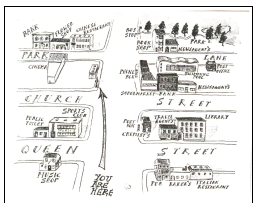Novosibirsk is the City I Study in
Novosibirsk is a big city. It’s territory is 491 km2. It’s Russia’s third largest city by area. With the population of nearly 1,500,000 people it’s the largest in Siberia and the 4th largest in Russia.
The city is located in Western Siberia, 18 hundred miles east of Moscow. It is located alongside the river Ob. Novosibirsk is divided into ten administrative districts, 2 of which are situated on the left and 8 – on the right bank of the Ob.
The history of the city is not very long. It is a little more than 100 years old. In 2007 Novosibirsk celebrated the 114th anniversary of its foundation (1893). At first it was a little settlement on the bank of the river Ob that was called Alexandrovsk. But it started growing up very quickly when a bridge across the river had been built. In 1895 it was called Novonikolaevsk. In 1903 it gained the status of a town. And in 1925 it was renamed Novosibirsk. During the World War II a lot of plants and factories from the European part of Russia were moved to Novosibirsk. This fact, though tragic, promoted the development of the city and the growth of the population. Today Novosibirsk is one of the main industrial, scientific, educational centres of Russia.
I wouldn't say that it is a very beautiful city though it has many sights. They are: the Opera and Ballet House that is well-know all over the world, the beautiful building of the Railway station, the theatre for young spectators "Globus", the drama theatre "Krasniy Fakel", the monument of Glory, the conservatoire, the circus and many others.
Although the city is growing and becoming more beautiful from day to day there are some serious problems in it. The most serious of them are: high cost of living and environmental pollution by transport and industry. I hope these problems will be solved by joint efforts of the city administration and residents of Novosibirsk.
Cлова к тексту:
| alongside (prep) | – вдоль |
| anniversary (n) | – годовщина |
| be located (v) | – находиться, быть расположенным |
| by joint efforts | – совместными усилиями |
| celebrate (v) | – праздновать |
| circus (n) [´sə:kəs] | – цирк |
| conservatoire (n) [kən´sə:vətwα:] | – консерватория |
| district (n) | – район |
| move (v) | – переезжать, перевозить |
| promote (v) | – способствовать |
| resident (n) [´rezıdent] | – житель |
| settlement (n) | – поселок |
| sight (n) | – достопримечательность |
| solve (v) | – решать, разрешать |
1.27. Дополните предложения, выбрав правильный вариант.
1. Novosibirsk is …
a) the largest city in Russia by area.
b) the third largest city in Russia by area.
c) the largest in the world.
2. The population of Novosibirsk is …
a) one million people.
b) two million people.
c) nearly one million and a half.
3. It gained the status of a town in …
a) 1893.
b) 1903.
c) 1925.
4. It was renamed Novosibirsk in …
a) 1925.
b) 1897.
c) 1903.
5. Novosibirsk is one of the main …
a) educational centres of Russia.
b) industrial and scientific centres of Russia.
c) industrial, scientific and educational centres of Russia.
6. Novosibirsk has …
a) many places of interest.
b) only theatres and cinemas.
c) no places of interest.
1.28. Ответьте на вопросы:
1. What is the territory of Novosibirsk?
2. How many people live in the city?
3. Where is it located?
4. How many administrative districts are there in the city?
5. How old is Novosibirsk?
6. When did it gain the status of a town?
7. What was its first name?
8. When was it renamed Novosibirsk?
9. Novosibirsk is one of the main industrial, scientific and educational centres of Russia, isn’t it? Prove.
10. What places of interest do you know?
11. Which is your favourite place in Novosibirsk? Why?
1.29. Напишите 4 абзаца о своем городе (столице). Начните каждый абзац с тех же самых слов, что в тексте о Лондоне (объем 100-120 слов).
1. How big is it? Where is it?
2. What is it famous for?
3. Does it have any environmental problems?
4. What do you like best of all in your city (town)?
1.30. Посмотрите на схему улиц типичного английского города. Прочитайте и переведите самостоятельно вывески различных учреждений. В случае затруднений, сверяйтесь с транскрипцией и переводом ниже.

baker’s [´beıkəz] – хлебный магазин, булочная
chemist’s [´kemısts] – аптека
lane [leın] – узкая улица, переулок
newsagent’s [´nju:zeıd3(ə)nts] – газетный киоск, издательство
travel agent’s [´trævleıd3ənts] – бюро путешествий
1.31. Посмотрите на схему улиц ещё раз и ответьте на вопросы:
1. Where can you buy bread?
2. Where can you buy a CD?
3. Where can you buy a plane ticket?
4. Where can you buy a book?
5. Where can you buy cigarettes?
6. Where can you take books?
1.32. В парах: составьте короткие диалоги по образцу, используя слова из таблицы:
A: Excuse me! Is there a chemist’s near here?
(Извините! Здесь есть поблизости аптека?)
B: Yes. It’s over there.
(Да. Вон там.)
A: Thanks.
(Спасибо.)
